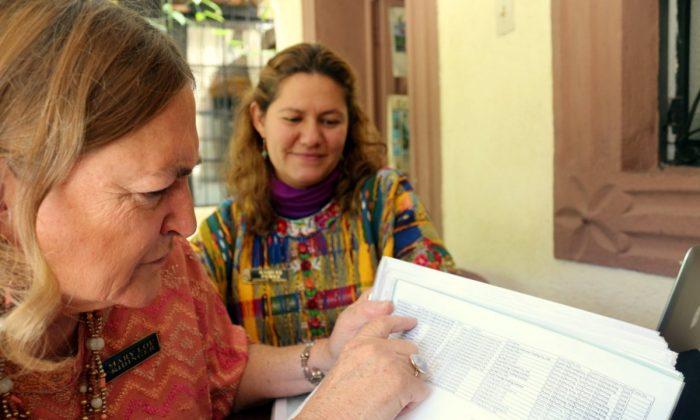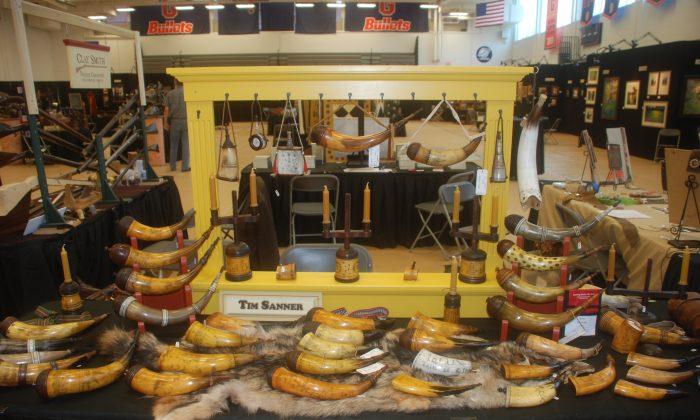ANTIGUA, Guatemala—She stands out in a crowd, any crowd anyplace. Tall, imposing Mary Louise Ridinger is an anthropologist-archaeologist. She has spent the last forty years living in Guatemala where she and her late husband Jay Ridinger rediscovered the ancient Mayan jade source in the Motagua Valley in Zacapa Province.
It has not been easy working in a country known for its violence in the past and its distressing present. Guatemala currently enjoys a vibrant tourism industry, where tourists are safer than in most countries.
The local crime level affects Guatemalans in their daily lives. Bribery and corruption are accepted as a way of doing business. Drug traffickers have found the business climate less challenging than in Colombia and Mexico where U.S. authorities have stepped up political pressure to stem the flow of illicit white powder.
What Guatemala has that other countries do not is jade. Mountains of jade.
“For the first ten years, we never allowed anyone to photograph our faces. We were afraid of kidnapping,” Ridinger said.
Her husband, also of considerable height, wore safari clothes and had a big bushy beard. Their son, who is 6-foot-8, is also in the jade business. You don’t have to see their faces to recognize these stanchions of America transplanted into the mountain jungles of this relatively small Central American country nestled between Mexico and El Salvador.
“Guatemala is on the Caribbean tectonic plate. The subduction faulting is where jade was formed. Imperial green jade is the world’s most valuable gemstone.” And there you have it. A nation of low-wage public officials; a nation vulnerable to exploitation of its natural resources; a nation with the most valuable gemstones in the world. A combination that sooner or later had to lead to the inevitable: illegal mining and smuggling.
To understand the value of jade, one must understand Chinese culture.
A History of Chinese Jade Theft
Jade is the stone of kings. It was, and still is, revered not only for its beauty, but also for its mystical properties. In China, jade is associated with immortality and eternity. Jade is virtually indestructible. It comes in two forms: nephrite, a silicate of magnesium and calcium; and jadeite, a silicate of aluminum and sodium. Various metals in jade account for its color varieties.
“In Mesoamerica, gold, silver, and emeralds were not valued as much as jade,” Ridinger said. “Gold can be melted, hammered, transformed from one shape to another. Jade, to the Maya, was the hardest and most enduring material available. It represented life, fertility and power. During China’s Qing Dynasty, the emperor reserved bright green jadeite for the royal family.”
Asian jade has been exploited over the centuries. “The name ‘China’ means ’the middle kingdom,'” Ridinger explained. “They never had jade. They went into other countries that had jade, like Korea, Turkistan, Taiwan, Kazakhstan, Burma, Japan, and Siberia. If you understand the history of jade, it is part of the history of China. They frequently invaded other countries for jade.”
Mary Lou Ridinger picked up the September 1987 issue of National Geographic Magazine. Her friend, gemologist Fred Ward, featured the Ridingers in a major article about Jade.
Devastation of Resource, Laborers
There are only two places in the world where jadeite can be found in commercial quantity: Burma (now Myanmar) and Guatemala. There are some 40 other green rocks that are carved by the Chinese. They are not jade. Only Jadeite and Nephrite are true jade. Jadeite Jade is much more valuable than nephrite jade.
“Here in Guatemala, Taiwanese nationals have been stealing Guatemala jade and shipping it illegally to Taiwan. They have been stealing it from my licensed areas. The people of Guatemala license me through their government. I pay for every pound of jade I take out. We only do surface collection.” Ridinger was adamant, her passion and dismay apparent.
“Jade mining around the world is driven by greed. It is all greed. It is destruction of the environment as well. Women miners in Burma are paid a pittance a day. This is what is going to happen in Guatemala. New governments come in here for four years without grasping ongoing projects,” she said.
Ridinger went to a poster display that contained photographs of their jade operation. “This is our jade mine. It’s a corn field. People sold us the property in 1975 and the sellers are still planting corn in their same fields. All they do is gather jade, pile it up there and we drive in and pick it up. They are doing a lot better than people in Burma. Our people are able to buy their trucks, motorcycles; they have their cell phones and properties. Their children go to school.”
The comparison was dramatic. In Burma, the exploitation of jade has left the environment in shambles and disrupted the lives of miners.
Pointing to an area on a map, Ridinger showed illegal strip-mining in Guatemala by Taiwanese. “There is not one piece of jade left in this area. It’s all in Taiwan illegally.”
“Taiwanese have come in here with back loaders, dynamite, and weapons. I only surface collect. For the last nine years it has been a cops and robbers story,” Ridinger said. “Doing surface collection methods used by the Mayas and Olmecs for thousands of years, future generations of Guatemalans will have jade for many thousands of years in the future.”
“We gave this information to the new government of Guatemala. We told them that if they don’t stop illegal strip mining, Guatemala will have no jade left in five years.”
“Twice I’ve successfully gotten rid of Taiwanese bandits. I don’t want to do it anymore. I have worked so hard for so many years to restore a lost tradition. I have helped restore jade carving of the ancient Maya back to the Maya heritage of Guatemala. I have been working on this as nine different governments have come and gone. It is time for the government to focus on the problem before all the jade is depleted,” she said.
A Legal Battle
Ridinger and her general manager, Raquel Perez, gathered evidence against Taiwanese national Marcos Wang and his family. Wang married one Catalina Gomez and has two daughters, one of whose names appears on shipping documents for exported jade.
Records Ridinger and Perez obtained from Guatemala’s Pacific coast port of Puerto Quetzal reveal 18 shipments of jade between Aug. 11, 2011, and Nov. 13, 2012, amounting to 500 tons.
“This has been going on for more than ten years. We sell jade for a minimum price of $30,000 a ton. Our bottom price for jade is $15 per pound. Look at what that amounts to. Let’s assume only 2,500 tons was smuggled out of Guatemala over the last ten years. That’s $100 million. I'd like to tell the people of Taiwan what they don’t know. All that jade was stolen from Guatemala. None of it got there legally,” Ridinger said.
Her Denuncia Verbal, or complaint, filed with the public prosecutor’s office in Zacapa on Jan. 9, 2012, accused Marcos Wang of theft and illegal export of jade. “This is the list of 25 shipments out of Puerto Quetzal. This list only started in 2011. We have pictures from 1998. Raquel and I have been investigating this case for ten years. We are good sleuths.”
Ridinger, serious until this point, laughed. Perez laughed. It broke the tension as they reviewed documents that revealed the extent of illegal jade trafficking in Guatemala and their travail to stop it.
The story of the seizure and arrest of one of Wang’s truck drivers is like a mystery thriller.
The Stakeout
They knew that Marcos Wang had an outside storage site for the jade he illegally mined. Ridinger and her team set up surveillance of the warehouse. She had been in touch with her contact at Guatemala’s Ministry of Mines. He gave her his personal cell phone number to call if anything developed.
Operatives alerted Ridinger of activity at the storage site. A truck was being loaded. Ridinger told her men to follow the truck and keep her posted on its location. She called the Ministry of Mines. The ministry ordered Guatemala’s Environmental Police to intercept the truck. They knew that local police were part of the corrupt cycle and could not count on them.
When the Environmental Police stopped the truck and ordered the driver to open its cargo area, he refused. He threatened the police with arrest if they opened the truck. Ridinger called her contact at the Ministry of Mines. He came to the site and personally ordered the truck to be opened. Inside was an illegal cargo of jade. The driver was arrested, the truck and its jade cargo seized.
The story didn’t end there. When the matter was brought before a local judge, the case was dismissed. Ridinger alleges corruption. Eventually, “The guy with jade in the warehouse was arrested and found guilty. The truck driver was found guilty.
“The case against Marcos Wang is pending. Local police can’t find him. His neighbors say they don’t know where he is. Another Taiwanese national, Luis Liu, 48, whose real name is Lui Jung Chih, has been convicted of illegal jade trafficking. He was sentenced to eight years house arrest,” Ridinger said, holding up Prensa Libre newspaper accounts of the arrests and convictions in December 2012.
Perseverance
“Mary Lou is being very brave,” Perez said. “She worries more for Guatemala and the future of its jade.”
Ridinger sifted through photographs taken of damage done to the land where jade has been dug out of the ground by Taiwanese criminals. “The illegal mining has not only been in your licensed area, but on your property. All those stones have been dug out. This photo shows the field where the Taiwanese have put all the jade they dug out together so they can put it on their truck,” Perez said, looking at the photographs.
“This is all very depressing,” Ridinger sighed. She has not let it rest. While her meetings with Guatemalan officials and ministers have fallen largely on deaf ears, her pursuit of the Taiwanese ambassador to Guatemala resulted in his promise to prosecute offenders.
Taiwanese Ambassador Adolfo Sun has been very active in helping Guatemalan infrastructure projects and support entrepreneurial activity.
“We know the other Taiwanese illegal jade dealer Mr. Lu is back in the country. He’s stayed in Taiwan working the jade connection. With the others exposed now, this man, we only know him by the name Lu, is back,” Ridinger said, concerned.
“I met with Ambassador Adolfo Sun in November. He told me that he will personally see that jade smugglers go to jail. I’ve sent evidence to the Taiwanese embassy in Guatemala City. I’ve never gotten one word back.”
Plenty Now, Poverty Later
Jadeite, the world’s most valuable gem stone, can be picked up from the ground in Guatemala’s remote mountains. With husbandry, the resource will remain for future generations to profit from. Mined and quarried by interests to quench Asia’s voracious thirst for the stone, it will be exhausted quickly, only to leave environmental devastation in its wake.
“The Guatemala government thought they'd have jade forever. That is true if there is only surface collection. New deposits come down with each rainy season. It is exposed in the mountains by alluvial action and it can just be picked up. Guatemala does not understand the difference between strip mining and surface collection. It is a preserve and we must treat it with respect,” Ridinger said.
“I started this industry. What if the jade is all in Taiwan and China and Guatemalans have no jade left? Jade is a gift from God to the people of Guatemala. This story is a story about greed. It is a worldwide story. By strip mining, people are destroying their own culture and the future of their children and grandchildren. It is hard for a poor country to understand this.”
Raquel Perez pulled out a large binder that contained photographs and evidence of jade-smuggling in Guatemala. The illicit traffic in jade continues virtually unabated. Mary Louise Ridinger and Raquel Perez persist in their struggle to stop it.
Perhaps in the end, if jadeite is valued by Guatemalans not simply as a precious gem, but also for its inherent mystical offering of good luck, prosperity, long life, fertility, health, immortality, and eternity, then the sources of jade will be respected and protected in Guatemala and its legacy will be preserved.
Her steadfast efforts to stem illegal mining in Guatemala, despite some low-level arrests, have been suppressed by corruption, she said. It is akin to blood diamonds from Africa. Until world attention is focused on what is an international crisis, no long-term solution will be undertaken.





